
Roberta and I both stopped at Slought Foundation Saturday, at separate times on different missions (see Roberta’s previous post). I was more focused on the work of Lenore Malen in the vault, and Roberta was more focused on Anastasi.
When we got together Monday to paint, I dismissed the Anastasi and she dismissed the Malen. She, on the other hand, defended Anastasi, and I defended Malen.
After reading Roberta’s post, which I found quite interesting–more interesting than I found Anastasi’s rather arcane show–I concluded for not the first time in my life that when you listen to an artist and his obsessions, even the most difficult work starts to make sense to you and seem worthwhile.
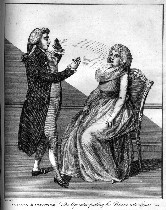 Now I have to say, right here, that Malen is a friend with whom I fell out of touch more than 20 years ago, so I do bring my delight in seeing her and what she’s up to to my argument.
Now I have to say, right here, that Malen is a friend with whom I fell out of touch more than 20 years ago, so I do bring my delight in seeing her and what she’s up to to my argument.
When I stopped by Slought in the afternoon, there was Malen, alone in the front of the gallery, setting up for the evening performance, and surprise, surprise, she looked exactly the same. Even more to my surprise, she said I looked exactly the same. (Sometimes, old friends can’t recognize me, so I’ve gotten used to the concept that I look quite different.)
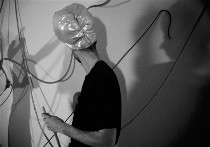
Leaving her to her work, I headed to the installation, a bunch of photos, a video and some artifacts–or were they “artifacts” (see image above left, its source labeled by Malen as A key to physic, and the occult sciences, by Ebenezer Sibly; London, 1795. Courtesy Bakken Library)?–telling the story of “The New Society for Universal Harmony,” a parodic version of a utopian society called La societe de l’harmonie universelle established in Paris in 1783 by followers of Franz Anton Mesmer (the mesmerism guy).
Malen’s photos of people and the place they went for a cure of whatever ails them showed a parody of a rustic spa, sort of chataqua meets mental hospital by the hot springs.
 (I suppose it was the back-to-nature, Victorian quality that made Roberta pop up with a comparison to the affect of Justine Kurland’s back-to-nature commune shots (her “Wood Song” shown here, left), and up to a point I suppose that argument could be made. But Kurland seems to have an intent other than parody.
(I suppose it was the back-to-nature, Victorian quality that made Roberta pop up with a comparison to the affect of Justine Kurland’s back-to-nature commune shots (her “Wood Song” shown here, left), and up to a point I suppose that argument could be made. But Kurland seems to have an intent other than parody.
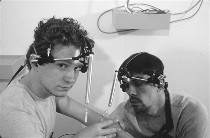 Slightly bizarre, slightly Victorian in affect and texture, Malen’s photos portrayed, in deadpan tone, earnest-looking people willing to believe anything and try anything in their search for a cure of whatever. A slide-show video of their faces and their overlapping stories was as poignant as it was silly. The artifacts, in library-like vitrines, were a mix of fact and fiction, including text and images about the original society.
Slightly bizarre, slightly Victorian in affect and texture, Malen’s photos portrayed, in deadpan tone, earnest-looking people willing to believe anything and try anything in their search for a cure of whatever. A slide-show video of their faces and their overlapping stories was as poignant as it was silly. The artifacts, in library-like vitrines, were a mix of fact and fiction, including text and images about the original society.
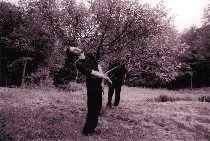 And the evening performance was Malen as Society archivist, in white lab coat with the Society emblem embroidered on the pocket, reporting her findings about the past society and the activities of the new one (the crowd favorite appeared to be the urban men “tied” to trees in the middle of a field, trying to reconnect to nature’s magnetic field, shown right).
And the evening performance was Malen as Society archivist, in white lab coat with the Society emblem embroidered on the pocket, reporting her findings about the past society and the activities of the new one (the crowd favorite appeared to be the urban men “tied” to trees in the middle of a field, trying to reconnect to nature’s magnetic field, shown right).
The accompanying slide show also included a tour of the New Society grounds, as in Here’s a cottage, here’s a bedroom, here’s an assembly room.
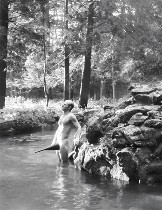
To me the highlight was the Freud-inspired case histories, with loopy sexual elements and odd obsessions.
Now this was a Saturday night at 6 p.m. out in West Philadelphia, a time that never would have drawn me in if Malen weren’t my friend. But Slought was jammed. More than 80 people showed up. And they laughed pretty hard at the performance.
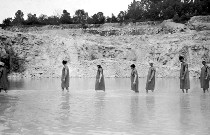
My personal interest, however, was less in the parody (which also includes a web-community parody), and more in what I saw as the dark side of the work–a serious anger with the human condition. Those society members as Malen photographed them looked so vulnerable in their ridiculousness, their desperate willingness to do foolish, useless things like dress in hospital gowns and white caps and socks while immersing themselves in a chilly natural pool. This is a parody of the failure of belief.
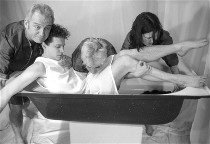 I suppose the parody was aimed at crystals and fringe medicine, but to me it read like a serious attack on the failure of conventional medicine and psychiatry (after all, why do people turn to crystals and the fringe?) The weird practices of the Harmonites seemed no less dehumanizing than a day of tests and manhandling in the hospital.
I suppose the parody was aimed at crystals and fringe medicine, but to me it read like a serious attack on the failure of conventional medicine and psychiatry (after all, why do people turn to crystals and the fringe?) The weird practices of the Harmonites seemed no less dehumanizing than a day of tests and manhandling in the hospital.
I think Malen’s work talked to Anastasi’s, with its academicism, its archiving and its references to past systems of thought.
Here, I thought, was a society that practiced, unwittingly, pataphysics–the science of imaginary solutions.
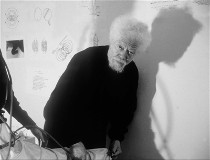
Some people I was with at Malen’s performance seemed discouraged by the conceptual approach of both her and Anastasi’s work. But like I said, listen hard enough to artists and their obsessions and you’ll find a way in to their most difficult work and come away having had an experience that was worth your while.
I ended up later that evening having several conversations with people who seemed unhappy with conceptual art as a whole. I “get” that unhappiness with conceptualism’s lack of sensory juice, but there’s satisfaction in the pleasures of thinking.
addendum: I got to wondering about how Malen and Slought found eachother; the answer, said Slought’s Aaron Levy, was Steve Clay at Granary Books, Inc., who approached Slought about co-publishing Malen’s book, “The New Society for Universal Harmony.” The book includes Malen’s original fiction plus essays from Nancy Princenthal, Irving Sandler, Pepe Karmel, et al.
A symposium on Mesmer and his beliefs is scheduled at Slought for April 3, 1:30 to 4:30 p.m.








